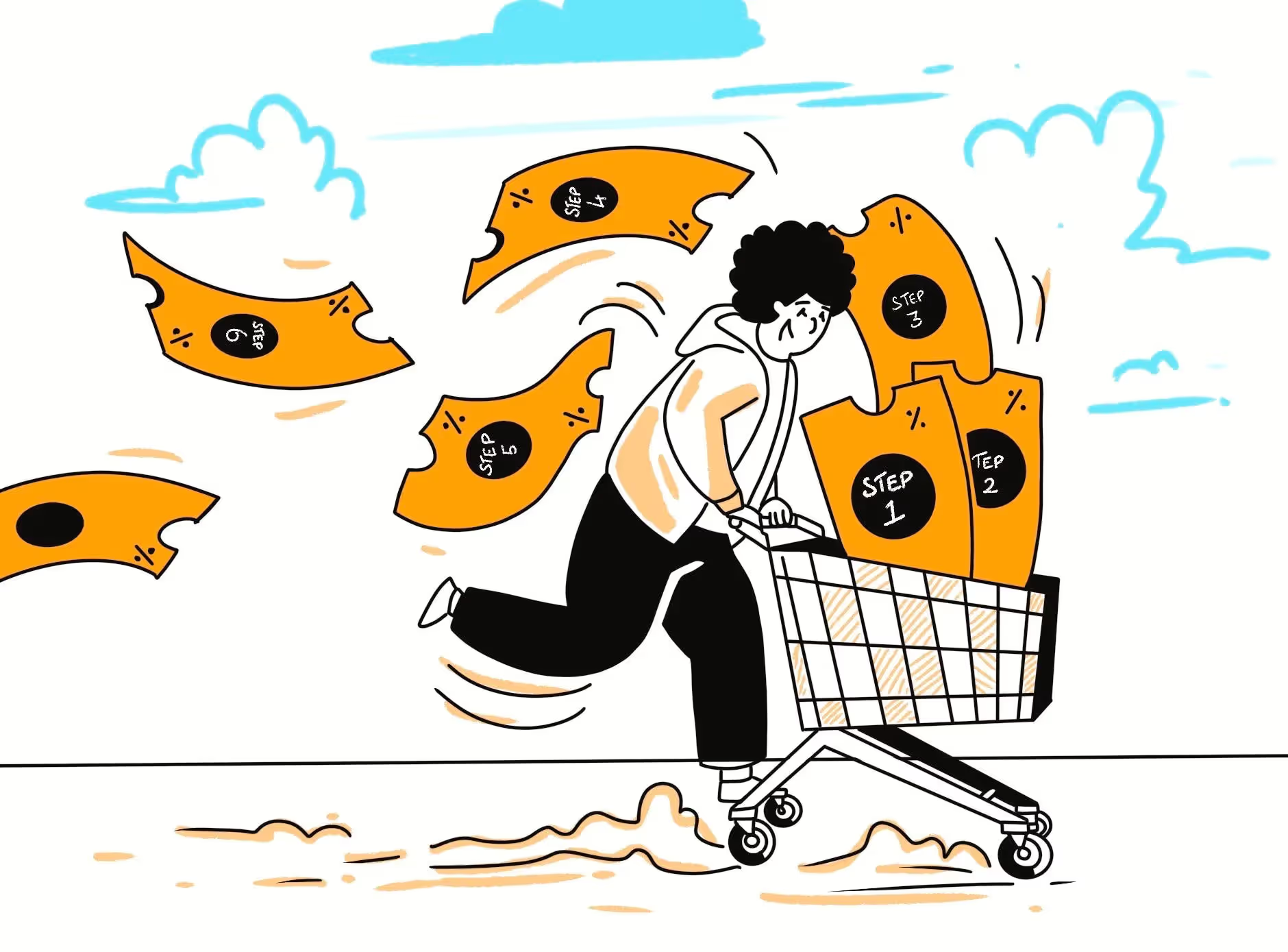


Key Takeaways
You’ve probably seen them before: coupons, discount codes, and other offers that marketers use to drive sales. If you’re like most business owners, you’ve probably also wondered if they work or why they work. After all, they’re just a tiny piece of paper or a few lines of code next to a price tag, right?
The truth is that coupons are more than just pieces of paper. They are powerful marketing tools to help you sell more products and services at higher profit margins. And that’s not just hyperbole; there’s science behind the effectiveness of coupons. Studies have shown that people are more likely to make purchases when there’s a coupon involved.
Some research suggests that over 60% of consumers will decide whether or not to buy from a company based on one! There is no better way to entice new customers when offering online courses than with a coupon. You don’t have to give up the farm on each sale, but even a small discount can go a long way toward building your user base and getting more people interested in your services. It is a common belief that online retailers only use coupons and discounts to increase sales. Internet-based retailers have long been using coupon codes to capture the attention of new customers and retain existing ones. The use of discounts by online retailers has become such a common practice that shoppers now expect to find offers and deals for anything they’re looking for on the internet.
The same logic applies to online courses. Most of us have come across free or discounted courses on Udemy or other e-learning platforms. However, offering coupons for your course does not simply mean attracting more students who would not otherwise pay full price for it. It can also help you boost the visibility of your course and make it easier for potential customers to find it among thousands of other similar products. Tons of people are taking online courses these days, as the pandemic has led to a surge in online learning. But not every person who buys an online course completes it. Studies show that about 80% of people who enrol in an online course never finish it. How do you get more people to complete your course and become successful as an online course creator? How do you make sure they don’t just buy your online course but enjoy it and want to buy more courses from you?
One way is by offering coupons for your online courses. That’s right: offer a coupon code that makes it easy for people to try out your course at a lower price. If you’re not sure where to start, the following tips will help you create an effective coupon that will improve your online course sales. This article will explain how you can promote your online course with a discount code and boost its sales without hurting your profit margin.
Why offer Coupons for your Online Courses?
You’ve got plenty of reasons to be hesitant about offering coupons or discounts for your course. After all, you’ve worked hard on making this content awesome, and you want people to pay full price for it. Coupons encourage impulse buying and allow you to attract new clients or reactivate old ones into buying new online courses.
You have five main reasons why you should consider offering coupons:
The act of offering coupons can help build your customer base and improve your sales in more ways than you might imagine.
1. Promote your content and reach new audiences through couponing
Creating coupons helps you promote your content and reach new audiences who might not have heard of you yet. It also helps you get more reviews on your course pages, which can help boost your course sales.
Some people will see the price of your course and procrastinate on whether or not they should sign up for it. By offering a limited-time discount, you can encourage them to take action as soon as possible before the deal expires. Coupons offer people an incentive to try your product or service for the first time, making it easier for you to get them in the door and win their business. And it can also motivate people to take action now instead of putting it off until later.
2. Your customers will feel like they’re getting a good deal and be more likely to buy from you again (and again)
If you have a product that isn’t selling well, consider offering a coupon code on social media and other platforms. There’s no better time to get your customers to buy from you than when they are already in the checkout line. It’s called an upsell, and it works like a charm. A great way to persuade customers to cross over to the bright side (i.e., spend more money) is by offering them a discount on an additional purchase or service. Your customers will feel like they’re getting a good deal and be more likely to buy from you again. And you’ll make more money. Everybody wins!
3. Get ahead of the competition
If you’re trying to decide how to set your prices, look at what your competitors charge for similar items and make sure you’re giving customers a good deal. If your product does more than theirs, you can charge more. If your competitors offer discounts for online courses or training, think about matching the offer if you can afford it. But remember customer service and brand integrity matter almost as much as low prices.
4. Coupons can create a sense of urgency and exclusivity
The psychology of discounts is incredibly powerful, and it has a ton to do with our decision making as humans. This is why you need to leverage that psychology. Here are some of the most important things to consider when considering discounts. People love free stuff. The word FREE is one of the most powerful words in any language. A considerable amount of people will take advantage of a discount, even when they don’t need the product or service. They will find a way to make it work for them or buy it for the sake of buying it with a discount.
People are used to paying more for better products, so keeping your prices high will likely keep them higher regarding perceived quality. But this is not always the case. Price is an essential factor, but there are other ways to influence how people perceive a product’s value. According to Dan Ariely and Michael Norton, when people have to calculate a final price, they perceive the product as worth more than something discounted from its original price. Therefore, having a higher price with a bigger discount looks like a better deal compared to having a smaller discount over a lower price tag.
Freebies: As I mentioned before, people love free stuff.
5. You’ll get the opportunity to up-sell if you offer coupons that are only valid if people spend over a certain amount of money
You can increase your profit margin by offering coupons that are valid only when shoppers spend a certain amount of money or more. This will help encourage people who might have been on the fence about buying something in the first place, or they may buy more than they originally intended to. You can also include a unique coupon code with your product purchases to encourage repeat customers. Give them a coupon code and tell them they’ll get 10% off their next purchase or something enticing like that.
Here are some tips for using coupons in your eCommerce business:
- Make them easy to find. If you’re offering coupons, make sure they’re easy to find – both on your website and across the web. You want to reach as many people as possible.
- Offer a discount on their next order. Customers won’t hesitate to use a coupon when they know it will save them money on their next purchase.
- Offer new customers a discount on their first order. Help customers get over that first-time-buyer hurdle with a unique code that will save them some money on their initial transaction with you. They’ll appreciate the gesture and be more likely to buy from you again (and again).
How to create a coupon online?
After learning about coupons’ importance, we will master crafting coupons to sell online courses. To prepare the most effective coupons, we will keep these things in mind:
- An attractive name - A catchy name will attract more potential customers, even if they don’t need anything from this particular store.
A coupon should have a clever and, at the same time, a short name to catch potential customers’ eye on the spot.
- Your coupon discount - Many people ask me about “how much to discount my online course”. And I admit, it is a difficult question to answer. However, it is easier than it seems. I have found some rules that can be used when setting discounts on products, and they work well.
The first rule is the rule of 100. This works like this: The rule of 100 If your product costs less than $100, always use a percentage-based discount. If it costs more than $100, always use a money-off discount.
So if your product costs $10, you can offer a 50% discount without feeling bad, but if you sell something for $1000, a 50% discount would mean you are giving away $500. That is never good business!
This means that if you want to offer a discount that feels like a lot, you should lower the price of your product.
- Date of expiry and limited-offer items - Another thing you should pay attention to is that the expiration date should be set at a reasonable time frame to avoid frustrating customers (time frame: as short as possible but not too short).
Coupons expire after a specific time, and learners need to know when they expired. A notification regarding this should appear on the page where coupons are listed so that learners can see them before making their purchases.
- The number of coupons you have matters - When creating offers, either for your own business or for clients, create a limited amount that will expire after a certain amount of time. This will give you more control over coupons, and you can better monitor the effectiveness of each coupon/promotion.
- Pay attention to the days and times! - Timing is essential when you want to promote your coupon offers. You can create offers to be redeemed on Mother’s Day, Father’s Day, or other holidays. You can target specific groups of people with your promotions–for example.
For example, January is the perfect time for a 30% off coupon for your winter collection. The same goes for summer sales and so on.
If you don’t want to create specific coupons for every holiday in the calendar, set up general seasonal coupons – like 20% off summer clothes or 10% off for all orders over $50.
- Figure out the financials - Course discount coupons can be an effective way of bringing new students to your classes. As you know, it takes some time and money to create a class, but once it’s there, it requires little effort to maintain. However, it would be best to think about how each coupon affects your bottom line.
If a coupon offers a high discount (like 80% off), customers probably won’t hesitate to buy it. But if you provide meager discounts too soon (like 10%), not only will you lose money on every sale, but it might also be hard to attract new students because they will expect such low prices in the future. To bring in new customers and not lose money on sales simultaneously, make sure your discounts are somewhere in the middle (like 50%).
Where to share your digital coupons?
- Promote your product by sending the coupons via email to your subscribers or customer list.
- Share your coupons with your friends via social media platforms.
- Reddit offers a great community of people interested in the same subjects. If there is a Reddit forum related to your niche with more than a hundred followers, take the time to post your coupons there.
- Create a craigslist post in a relevant business or service category to offer your discount. The text-only coupon will do the trick.
- You can add a banner with your coupon code to your website for a seasonal or limited-time offer.
Conclusion
Selling online courses is relatively new and challenging, but you do not have to be afraid of it. After brainstorming what we could provide our customers to promote sales, we realized that offering a discount code was the best way to communicate with students effectively. By considering your offerings and promotion strategy, you can increase student enrollment in your online course and promote your business more effectively.
Coupons, compared to free resources, offer a deeply discounted price. This helps with conversions, but it might also help you get past the wallet pain point when selling training courses with higher price tags. Coupons are a great way to incentivise sales and build customer loyalty. In an eCommerce store, there are many ways to leverage the power of coupons. EdisonOS offers a robust coupon system that provides the ability to customize coupons based on client requirements, niche and much more.
In Edison, coupons are objects that are applied to an invoice and reduce the value of the invoice for a specified amount or percentage. Coupons can be applied to specific subscriptions or all subscriptions belonging to a customer. Coupons have three properties:
- Value: This is the value of the discount. It can be either fixed or percentage-based.
- Duration: The duration determines how long a coupon will be valid after it has been redeemed by a customer.
- Redemptions: The number of times that a coupon can be used. A redemptions property of null indicates that the coupon can be redeemed an unlimited number of times.
For example, one of the clients wanted to provide a special discount for their product to their existing customers for their loyalty. They used to manually give them coupon codes which was very time-consuming. After integration with EdisonOS, we created a workflow that automatically generated coupons for the customer who had spent over a certain amount of money in their store. Not only does it help them increase revenue but also increased customer satisfaction by providing discounts.
If you’re looking to create your online course, hopefully, this will help you think about making a product that people might buy!
Recommended Reads
Recommended Reads












.png)
.webp)
